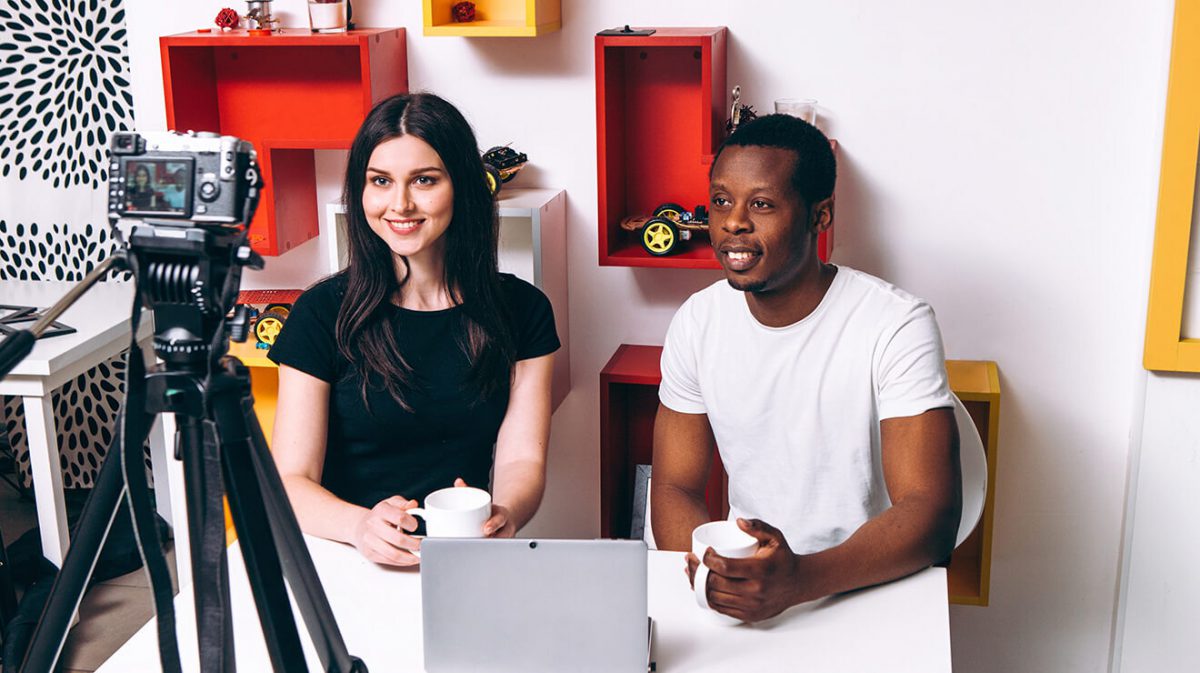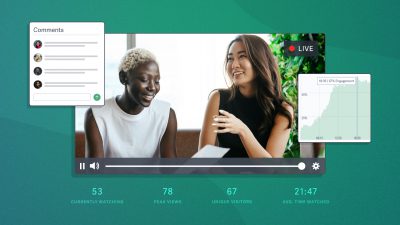(Photo Credit: Blogger Startup By golubovystock on Shutterstock)
For many companies, it’s hard to come up with alternatives to in-person events that are just as effective for marketing. It’s really tough to replace the human connection and excitement that naturally comes with meeting people in real life.
Live video is quite possibly as close as you can get, and has proven to be a highly engaging and effective solution to scaling events, drumming up excitement, and delivering a message. In this post, we’ll look at four innovative ways brands have leveraged live streaming to replace in-person events.
1. Shoppable Product Demos
Many brands are used to holding large events to announce new product features or launches. These events usually generate plenty of buzz, and get potential customers really excited about new features.
While it’s hard to replace the energy of a live audience, live video events offer a few advantages. The reach is theoretically unlimited, so you aren’t constrained by venue capacity or location. And you can still gather plenty of direct feedback and generate lots of excitement in different ways.
After all, many of the best product-centric events have been incorporating live video for years. The trick is to figure out ways to pull potential customers in and keep them engaged.
This past September, Samsung Sweden launched the new Galaxy Z Fold2 5G. They did everything you would do at an in-person event: an unboxing, audience participation, and a Q&A session. The most innovative aspect was that the live stream was shoppable, so consumers did not have to wait to make a purchase while watching.
To replicate this on a smaller scale, you’ll first need a plan of action. Check out the breakdown of our first live steam where we demoed our new live streaming capabilities.
2. Live Conferences
Virtual conferences have been on the rise for some time, but engagement has been skyrocketing since they’re now essentially the only option. Online conferences offer some specific advantages over in-person events. You can still run multiple sessions with different speakers, but capturing the insights is much easier. Also, attendees can tune in live, or to the recording when they have time, helping to boost your reach and engagement. Finally, speakers can participate from wherever they happen to be, reducing scheduling conflicts and travel headaches.
When location and venue are no longer a factor for the size or length of your conference, you can really start to push some boundaries. While most conferences last less than a week, Social Media Week held a month-long virtual conference series earlier this year. They had over 300 speakers and 150 sessions. If that sounds potentially overwhelming, they gave attendees access to recordings and recaps if they weren’t able to attend live.
While you might not have the capacity to hold a month-long virtual conference, embracing the flexible nature of virtual events can lead to new formats and more opportunities to engage participants.
3. Virtual Party
Throwing a party might be the exact thing you need to lighten things up and spread some cheer for your audience as the pandemic continues. Since we went into lockdown, virtual happy hours, board games, and dance parties have skyrocketed. There are plenty of ways to leverage this trend for your own brand.
Hormel Foods did just that. During what they called ‘Hormel Foods Spirit Week’, they held a virtual pizza party to celebrate plant workers and staff during the pandemic. Not only did they give out prizes and have special guests, but they also broke a world record for a virtual pizza party.
When coming up with your virtual party concept, look for ways to generate excitement and promote audience interaction. From polls to surprise guests, there are many options to get the party started.
4. Behind-the-Scenes
Going live behind-the-scenes has a certain caché, and is an amazing way to share insights or exclusive knowledge with viewers. The beauty of behind-the-scenes content is that it can be applicable to just about any industry.
For instance, you could feature interviews with employees, break down marketing videos, show a day in the life of an executive, or reveal part of the manufacturing process. You can get very creative with it.
Warner Brothers used behind-the-scenes content to generate new interest in some iconic films. Utilizing a mix of live and prerecorded materials, Warner Brothers created a nostalgic experience that provided a true insider perspective to those watching along.
If you’ve been sitting on some archival footage, or have a crazy story to tell about how something came together at the last minute, live video is the perfect way to share.
Bonus: Add More Nostalgia With VIPs
One trend we’ve seen during quarantine is live video reunions for some very popular shows. While this might seem like just a fun get-together of old cast members, it can be extremely powerful.
Tapping into nostalgia for shows we already watched and loved can generate cravings for that same comfort. Seeing your favorite stars from shows like Parks and Recreation, Community, and Happy Endings and more, will definitely entice you to go back and rewatch those series.
Along with driving views, many of these virtual get-togethers were for charity or spreading positive messages during an uncertain time. Look for authentic tie-ins for your brand, and use nostalgia to give your audience something to smile about.
Live video is going to continue to gain traction as more and more businesses find successful strategies for implementing it. There’s no time like the present to start experimenting to see what works for your audience. Let us know in the comments below which strategies you’ll be trying, or if you’ve found any other unique ways of using live video.








